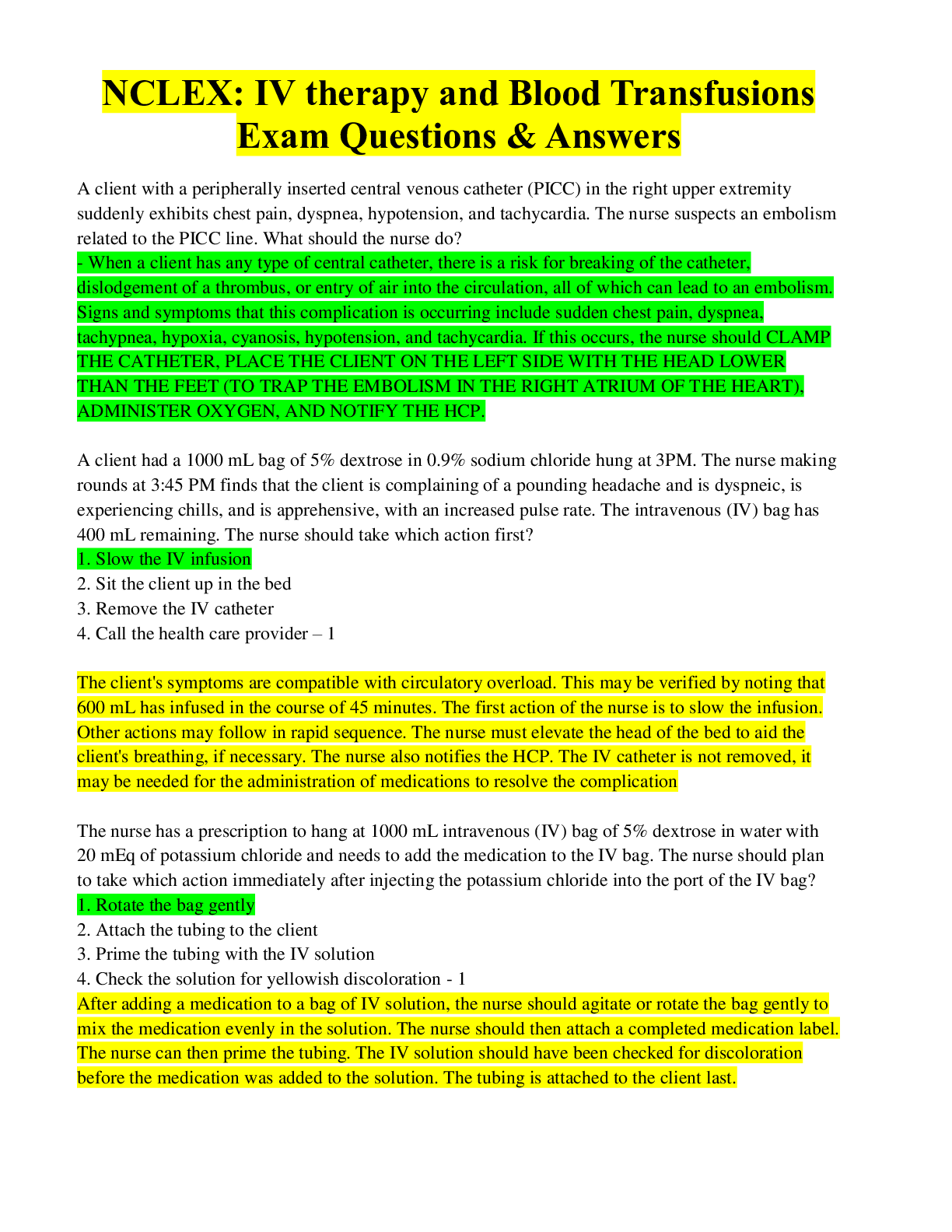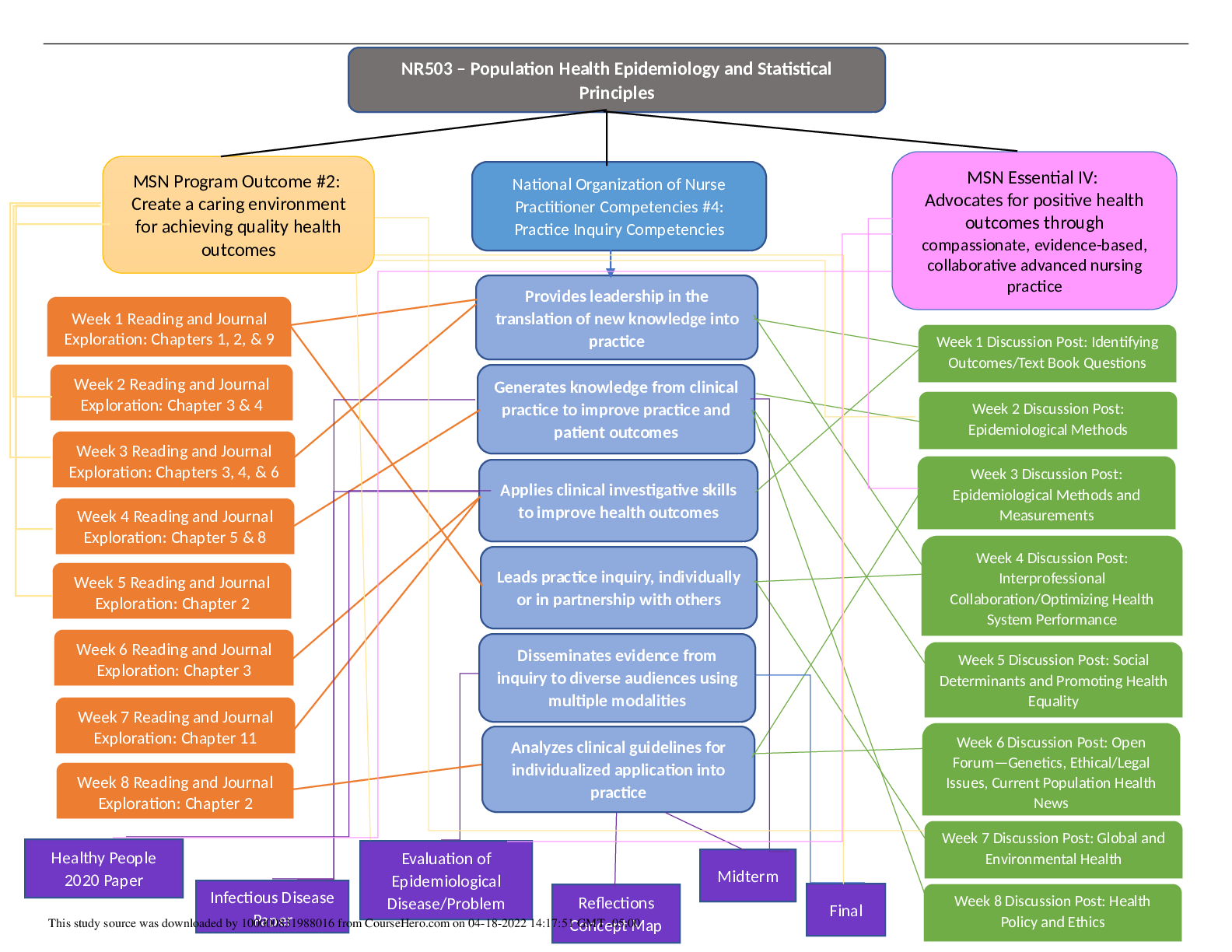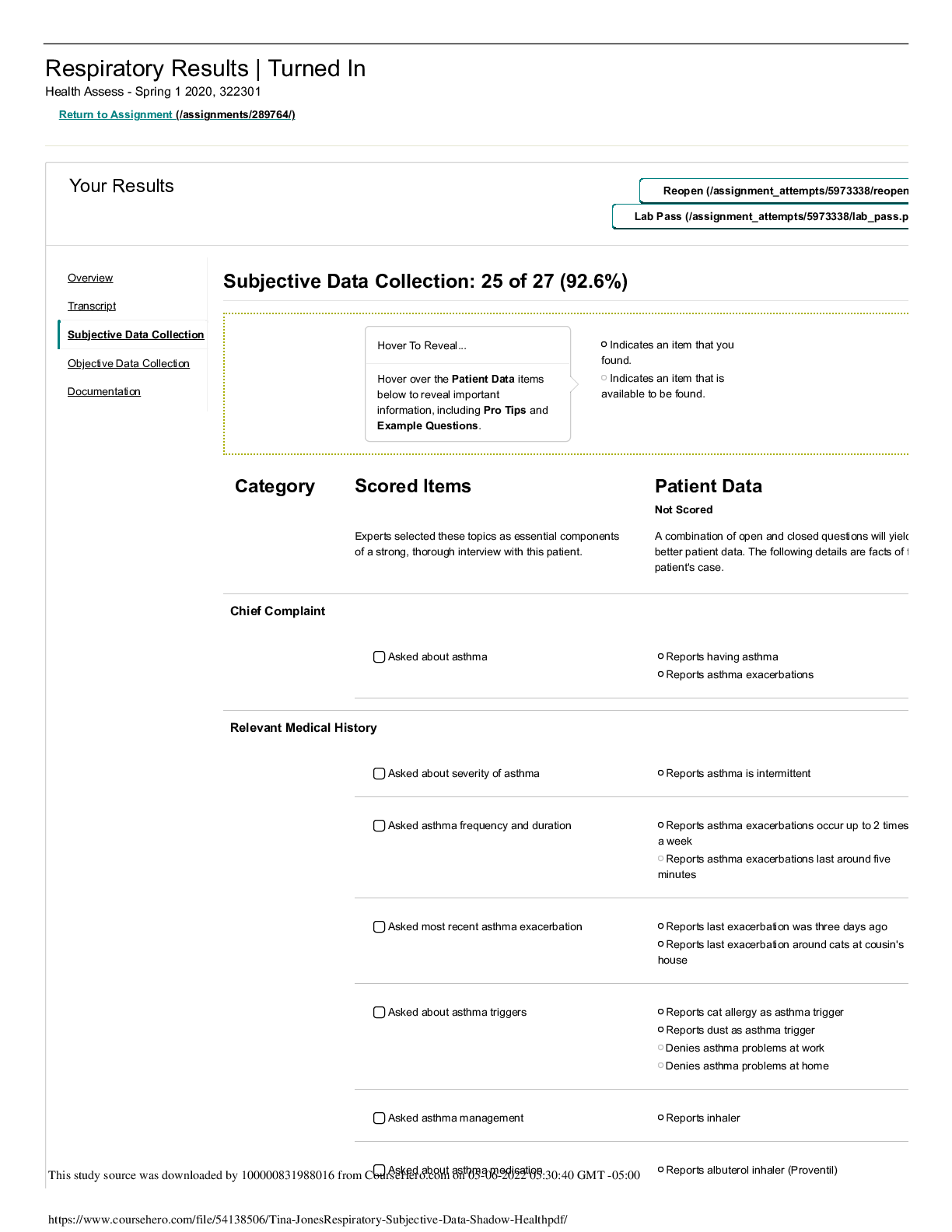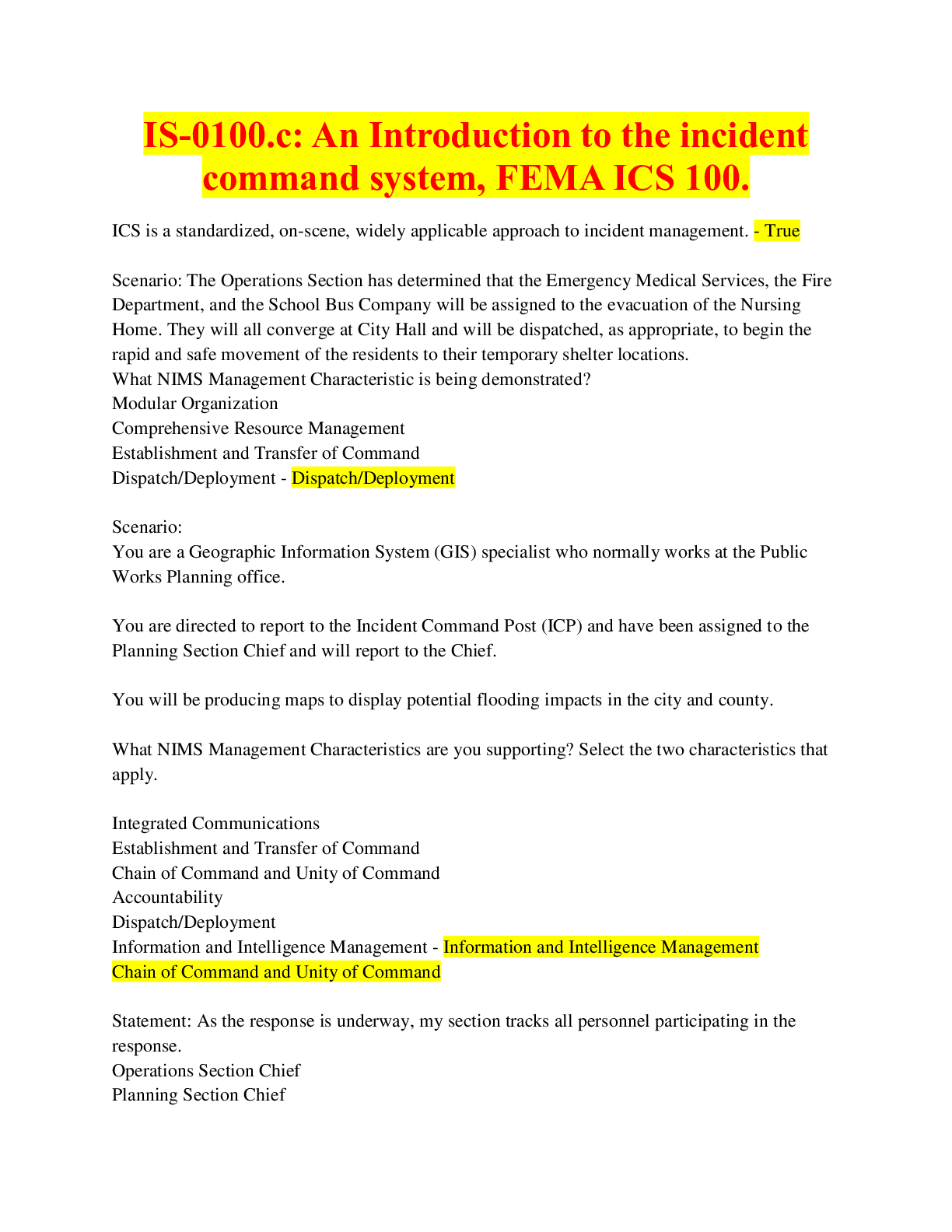NCLEX: IV therapy and Blood Transfusions Exam Questions & Answers
Document Content and Description Below
NCLEX: IV therapy and Blood Transfusions Exam Questions & Answers -A client with a peripherally inserted central venous catheter (PICC) in the right upper extremity suddenly exhibits chest pain, dyspn... ea, hypotension, and tachycardia. The nurse suspects an embolism related to the PICC line. What should the nurse do? - When a client has any type of central catheter, there is a risk for breaking of the catheter, dislodgement of a thrombus, or entry of air into the circulation, all of which can lead to an embolism. Signs and symptoms that this complication is occurring include sudden chest pain, dyspnea, tachypnea, hypoxia, cyanosis, hypotension, and tachycardia. If this occurs, the nurse should CLAMP THE CATHETER, PLACE THE CLIENT ON THE LEFT SIDE WITH THE HEAD LOWER THAN THE FEET (TO TRAP THE EMBOLISM IN THE RIGHT ATRIUM OF THE HEART), ADMINISTER OXYGEN, AND NOTIFY THE HCP. A client had a 1000 mL bag of 5% dextrose in 0.9% sodium chloride hung at 3PM. The nurse making rounds at 3:45 PM finds that the client is complaining of a pounding headache and is dyspneic, is experiencing chills, and is apprehensive, with an increased pulse rate. The intravenous (IV) bag has 400 mL remaining. The nurse should take which action first? 1. Slow the IV infusion 2. Sit the client up in the bed 3. Remove the IV catheter 4. Call the health care provider – 1 The client's symptoms are compatible with circulatory overload. This may be verified by noting that 600 mL has infused in the course of 45 minutes. The first action of the nurse is to slow the infusion. Other actions may follow in rapid sequence. The nurse must elevate the head of the bed to aid the client's breathing, if necessary. The nurse also notifies the HCP. The IV catheter is not removed, it may be needed for the administration of medications to resolve the complication The nurse has a prescription to hang at 1000 mL intravenous (IV) bag of 5% dextrose in water with 20 mEq of potassium chloride and needs to add the medication to the IV bag. The nurse should plan to take which action immediately after injecting the potassium chloride into the port of the IV bag? 1. Rotate the bag gently 2. Attach the tubing to the client 3. Prime the tubing with the IV solution 4. Check the solution for yellowish discoloration - 1 After adding a medication to a bag of IV solution, the nurse should agitate or rotate the bag gently to mix the medication evenly in the solution. The nurse should then attach a completed medication label. The nurse can then prime the tubing. The IV solution should have been checked for discoloration before the medication was added to the solution. The tubing is attached to the client last. The nurse is completing a time tape for a 1000 mL IV bag that is scheduled to infuse over 8 hours. The nurse has just placed the 11AM marking at the 500 mL level. The nurse should place the mark for noon at which numerical level (mL) on the time tape? _____ mL - 375 mL If the IV is scheduled to run over 8 hours, then the hourly rate is 125 mL/hr. Using 500 mL as the reference point, the next hourly marking would be at 375 mL, which is 125 mL less than 500. The nurse is making initial rounds on the nursing unit to assess the condition of assigned clients. The nurse notes that a client's intravenous (IV) site is cool, pale, and swollen, and the solution is not infusing. The nurse concludes that which complication has occured? 1. Infection 2. Phlebitis 3. Infiltration 4. Thrombosis – 3 An infiltrated IV is one that has dislodged from the vein and is lying in subcutaneous tissue. Pallor, coolness, and swelling are the results of IV fluid being deposited in the subcutaneous tissue. When the pressure in the tissues exceeds the pressure in the tubing, the flow of the IV solution will stop. The corrective action is to remove the catheter and start a new IV line at another site. Infection, phlebitis, and thrombophlebitis are likely to be accompanied by warmth at the site, not coolness. The nurse is inserting an intravenous line into a client's vein. After the initial stick, the nurse would continue to advance the catheter in which situation? 1. The catheter advances easily 2. The vein is distended under the needle 3. The client does not complain of discomfort 4. Blood return shows in the backflash chamber of the catheter – 4 The IV catheter has entered the lumen of the vein successfully when blood backflash shows in the IV catheter. The vein should have be distended by the tourniquet before the vein was cannulated. Client discomfort varies with the client, the site, and the nurse's insertion technique and is not a reliable measure of cathater placement. The nurse should not advance the catheter until the placement in the vein is verified by blood return. The nurse notes that the site of a client's peripheral intravenous (IV) catheter is reddened, warm, painful, and slightly edematous proximal to the insertion point of the IV catheter. After taking appropriate steps to care for the client, the nurse should document in the medical record that the client experienced which condition? 1. Phlebitis of the vein 2. Infiltration of the IV line 3. Hypersensitivity to the IV solution 4. Allergic reaction to the IV catheter material – 1 Phlebitis at an IV site can be distinguished by client discomfort at the site and by redness, warmth, and swelling proximal to the catheter. If phlebitis occurs, the nurse should discontinue the IV line and insert a new IV line at a different site. Coolness at the site would be noted if the IV catheter was infiltrated. An allergic reaction produces a rash, redness, and itching. A mahor reaction, such as hypersensitivity, can cause dyspnea, a swollen tongue, and cyanosis. The nurse is preparing a continous intravenous (IV) infusion at the medication cart. As the nurse goes to insert the spike end of the IV tubing into the IV bag, the tubing drops and the spike end hits the top of the medication cart. The nurse should take which action? 1. Obtain a new IV bag 2. Obtain new IV tubing 3. Wipe the spike end of the tubing with betadine 4. Scrub the spike end of the tubing with an alcohol swab – 2 The nurse should obtain new IV tubing because contamination has occurred and could cause systemic infection to the client. There is no need to obtain a new IV bag because the bag was not contaminated. Wiping with Betadine or alcohol is insufficient and is contraindicated because the spike will be inserted into the IV bag. A health care provider has written a prescription to discontinue an intravenous (IV) line. The nurse should obtain which item from the unit supply area for applying pressure to the site after removing the IV catheter? 1. Elastic wrap 2. Betadine swab 3. Adhesive bandage 4. Sterile 2x2 gauze – 4 A dry sterile dressing such as a sterile 2x2 is used to apply pressure to the discontinued IV site. This material is absorbent, sterile, and nonirritating. A Betadine swab would irritate the opened puncture site and would not stop the blood flow. An adhesive bandage or elastic wrap may be used to cover the site once hemostasis has occurred. A client rings the call bell and complains of pain at the site of an intravenous (IV) infusion. The nurse assesses the site and determines that phlebitis has developed. The nurse should take which action(s) in the care of this client? Select all that apply. 1. Notify the health care provider 2. Remove the IV catheter at the site 3. Apply warm moist packs to the site 4. Start a new IV line in a proximal portion of the same vein 5. Document the occurrence, actions taken, and the client's response - 1, 2, 3, 5 Phlebitis is an inflammation of the vein that can occur from mechanical or chemical (medication) trauma or from a local infection and can cause the development of a clot (thrombophlebitis). The nurse should remove the IV at the phlebitic site and apply warm moist compresses to the area to speed resolution of the inflammation. Because phlebitis has occurred, the nurse also notifies the HCP about IV complication. The nurse should restart the IV in a vein other than the one that has developed phlebitis. FInally the nurse documents the occurrence, actions taken, and the client;s response. A client involved in a motor vehicle crash presents to the emergency department with severe internal bleeding. The client is severely hypotensive and unresponsive. The nurse anticipates that which intravenous solution will most likely be prescribed to increase intravascular volume, replace immediate blood loss volume, and increase blood pressure? 1. 5% dextrose in lactated ringer's 2. 0.33% sodium chloride (1/3 normal saline) 3. 0.225% sodium chloride (1/4 normal saline) 4. 0.45% sodium chloride (1/2 normal saline) – 1 The goal of therapy with this client is to expand intravascular volume as quickly as possible. The 5% dextrose in lactated ringer's (hypotonic solution) would increase intravascular volume and immediately replace lost fluid volume until a transfusion can be administered, resulting in an increase in the client's blood pressure. The solutions in the remaining options would not be given to this client because they are hypotonic solutions and, instead of increasing intravascular space, the solutions would move into the cells via osmosis The nurse provides a list of instructions to a client being discharged to home with a peripherally inserted central catheter (PICC). The nurse determines that the client needs further instructions if the client made which statement? 1. "I need to wear a Medic-Alert tag or bracelet." 2. "I need to restrict my activity while this catheter is in place." 3. "I need to have a repair kit available in the home for use if needed." 4."I need to keep the insertion site protected when in the shower or bath." – 2 The client should be taught that only minor activity restrictions apply with this type of catheter. The client should protect the site during bathing and should carry or wear a Medic-Alert identification. The client should have a repair kit in the home for use as needed because the catheter is for long-term use. A client has just undergone insertion of a central venous catheter at the bedside. The nurse would be sure to check which results before initiating the flow rate of the client's intravenous (IV) solution at 100 mL/hr? 1. serum osmolality 2. serum electrolyte levels 3. portable chest xray film 4. intake and output recors - 3 Before beginning administration of IV solution, the nurse should assess whether the chest radiograph reveals that the central catheter is in the proper place. This is necessary to prevent infusion of IV fluid into pulmonary or subcutaneous tissues. The other options represent items that are useful for the nurse to be aware of in the general care of this client, but they do not relate to this procedure. A client with the recent diagnosis of myocardial infarction and impaired renal function is recuperating on the step-down cardiac unit. The client's blood pressure has been borderline low and intravenous (IV) fluids have been infusing at 100 mL/hr via a central line catheter in the right internal jugular for approximately 24 hrs to increase renal ouput and maintain the blood pressure. Upon entering the client's room, the nurse notes that the client is breathing rapidly and is coughing. The nurse determine that the client is most likely experiencing which complication of IV therapy? 1. Hematoma 2. Air embolism 3. Systemic infection 4. Circulatory overload - 4 Circulatory (fluid) overload is a complication of intravenous therapy. Signs include rapid breathing, dyspnea, a moist cough, and crackles. When circulatory overload is present, the client's blood pressure also increases. Hematoma is characterized by ecchymosis, swelling, and leakage at the IV insertion site, as well as hard and painful lumps at the site. Air embolism is characterized by tachycardia, dyspnea, hypotension, cyanosis, and decreased level of conciousness. Systemic infection is characterized by chills, fever, malaise, headache, nausea, vomiting, backache, and tachycardia. The nurse is administering 1 unit of packed red blood cells (PRBCs) to a client who has never received a blood transfusion. The client suddenly becomes apprehensive and complains of back pain after the first 10 minutes of administration. What should the nurse do? - Signs of an immediate transfusion reaction include the following: chills, and diaphoresis; muscle aches, back pain, or chest pain; rash, hives, itching, and swelling; rapid, thready pulse; dyspnea, cough, or wheezing; pallor or cyanosis; apprehension; tingling and numbness; headache; and nausea, vomiting, abdominal cramping, and diarrhea. In the event that a transfusion reaction is suspected, the nurse should FIRST STOP THE INFUSION. The nurse should then CHANGE THE IV TUBING DOWN TO THE IV SITE, KEEP THE IV LINE OPEN W/NS, NOTIFY HCP AND BLOOD BANK, and RETURN BLOOD BAG AND TUBING TO THE BLOOD BANK. The nurse should COLLECT A URINE SPECIMEN. The nurse IMPLEMENTS PRESCRIPTIONS and STAYS WITH THE CLIENT and MONITORS THE CLIENT CLOSELY UNTIL STABILIZED. Packed red blood cells (PRBCs) - - blood product used to replace RBCs; infusion time for 1 unit usually 2-4hrs - 1 unit = 1 g/dL increase in Hgb; 3% increase in Hct; change in labs takes 4-6 hrs after completion of transfusion - Evaluation of effective response based on resolution in RBC, Hgb, Hct Washed red blood cells - - depletion of plasma, platelets, and leukocytes) may be prescribed for clients w/ Hx of allergic transfusions or those who underwent hematopoietic stem cell transplant*** Platelet transfusion - - used to Tx thrombocytopenia and platelet dysfunction - crossmatching not required but usually done (contain few RBCs) - volume may vary, always check bag for volume - plts administered immediately upon receipt from blood bank and given RAPIDLY for 15-30 minutes - effective response based on increased plt; plt count evaluated 1 hr and 18 to 24 hrs after transfusion - 1 unit = 5,000 - 10,000 cells/mm3 increase expected [Show More]
Last updated: 1 year ago
Preview 1 out of 25 pages
Instant download

Buy this document to get the full access instantly
Instant Download Access after purchase
Add to cartInstant download
Reviews( 0 )
Document information
Connected school, study & course
About the document
Uploaded On
Dec 29, 2022
Number of pages
25
Written in
Additional information
This document has been written for:
Uploaded
Dec 29, 2022
Downloads
0
Views
76















